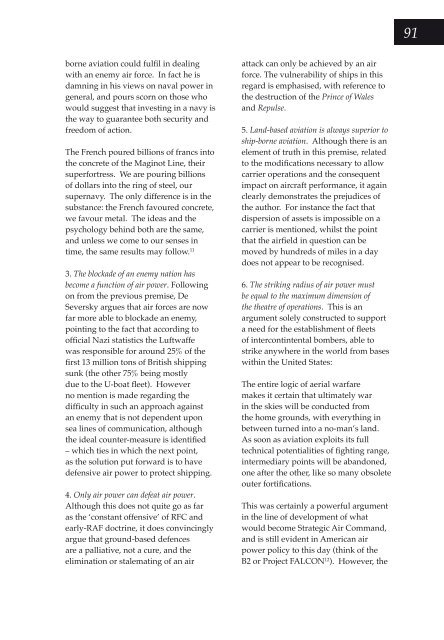REVIEW - Royal Air Force Centre for Air Power Studies
REVIEW - Royal Air Force Centre for Air Power Studies
REVIEW - Royal Air Force Centre for Air Power Studies
You also want an ePaper? Increase the reach of your titles
YUMPU automatically turns print PDFs into web optimized ePapers that Google loves.
orne aviation could fulfil in dealing<br />
with an enemy air <strong>for</strong>ce. In fact he is<br />
damning in his views on naval power in<br />
general, and pours scorn on those who<br />
would suggest that investing in a navy is<br />
the way to guarantee both security and<br />
freedom of action.<br />
The French poured billions of francs into<br />
the concrete of the Maginot Line, their<br />
super<strong>for</strong>tress. We are pouring billions<br />
of dollars into the ring of steel, our<br />
supernavy. The only difference is in the<br />
substance: the French favoured concrete,<br />
we favour metal. The ideas and the<br />
psychology behind both are the same,<br />
and unless we come to our senses in<br />
time, the same results may follow. 11<br />
3. The blockade of an enemy nation has<br />
become a function of air power. Following<br />
on from the previous premise, De<br />
Seversky argues that air <strong>for</strong>ces are now<br />
far more able to blockade an enemy,<br />
pointing to the fact that according to<br />
official Nazi statistics the Luftwaffe<br />
was responsible <strong>for</strong> around 25% of the<br />
first 13 million tons of British shipping<br />
sunk (the other 75% being mostly<br />
due to the U-boat fleet). However<br />
no mention is made regarding the<br />
difficulty in such an approach against<br />
an enemy that is not dependent upon<br />
sea lines of communication, although<br />
the ideal counter-measure is identified<br />
– which ties in which the next point,<br />
as the solution put <strong>for</strong>ward is to have<br />
defensive air power to protect shipping.<br />
4. Only air power can defeat air power.<br />
Although this does not quite go as far<br />
as the ‘constant offensive’ of RFC and<br />
early-RAF doctrine, it does convincingly<br />
argue that ground-based defences<br />
are a palliative, not a cure, and the<br />
elimination or stalemating of an air<br />
attack can only be achieved by an air<br />
<strong>for</strong>ce. The vulnerability of ships in this<br />
regard is emphasised, with reference to<br />
the destruction of the Prince of Wales<br />
and Repulse.<br />
5. Land-based aviation is always superior to<br />
ship-borne aviation. Although there is an<br />
element of truth in this premise, related<br />
to the modifications necessary to allow<br />
carrier operations and the consequent<br />
impact on aircraft per<strong>for</strong>mance, it again<br />
clearly demonstrates the prejudices of<br />
the author. For instance the fact that<br />
dispersion of assets is impossible on a<br />
carrier is mentioned, whilst the point<br />
that the airfield in question can be<br />
moved by hundreds of miles in a day<br />
does not appear to be recognised.<br />
6. The striking radius of air power must<br />
be equal to the maximum dimension of<br />
the theatre of operations. This is an<br />
argument solely constructed to support<br />
a need <strong>for</strong> the establishment of fleets<br />
of intercontintental bombers, able to<br />
strike anywhere in the world from bases<br />
within the United States:<br />
The entire logic of aerial warfare<br />
makes it certain that ultimately war<br />
in the skies will be conducted from<br />
the home grounds, with everything in<br />
between turned into a no-man’s land.<br />
As soon as aviation exploits its full<br />
technical potentialities of fighting range,<br />
intermediary points will be abandoned,<br />
one after the other, like so many obsolete<br />
outer <strong>for</strong>tifications.<br />
This was certainly a powerful argument<br />
in the line of development of what<br />
would become Strategic <strong>Air</strong> Command,<br />
and is still evident in American air<br />
power policy to this day (think of the<br />
B2 or Project FALCON 12 ). However, the<br />
91

















